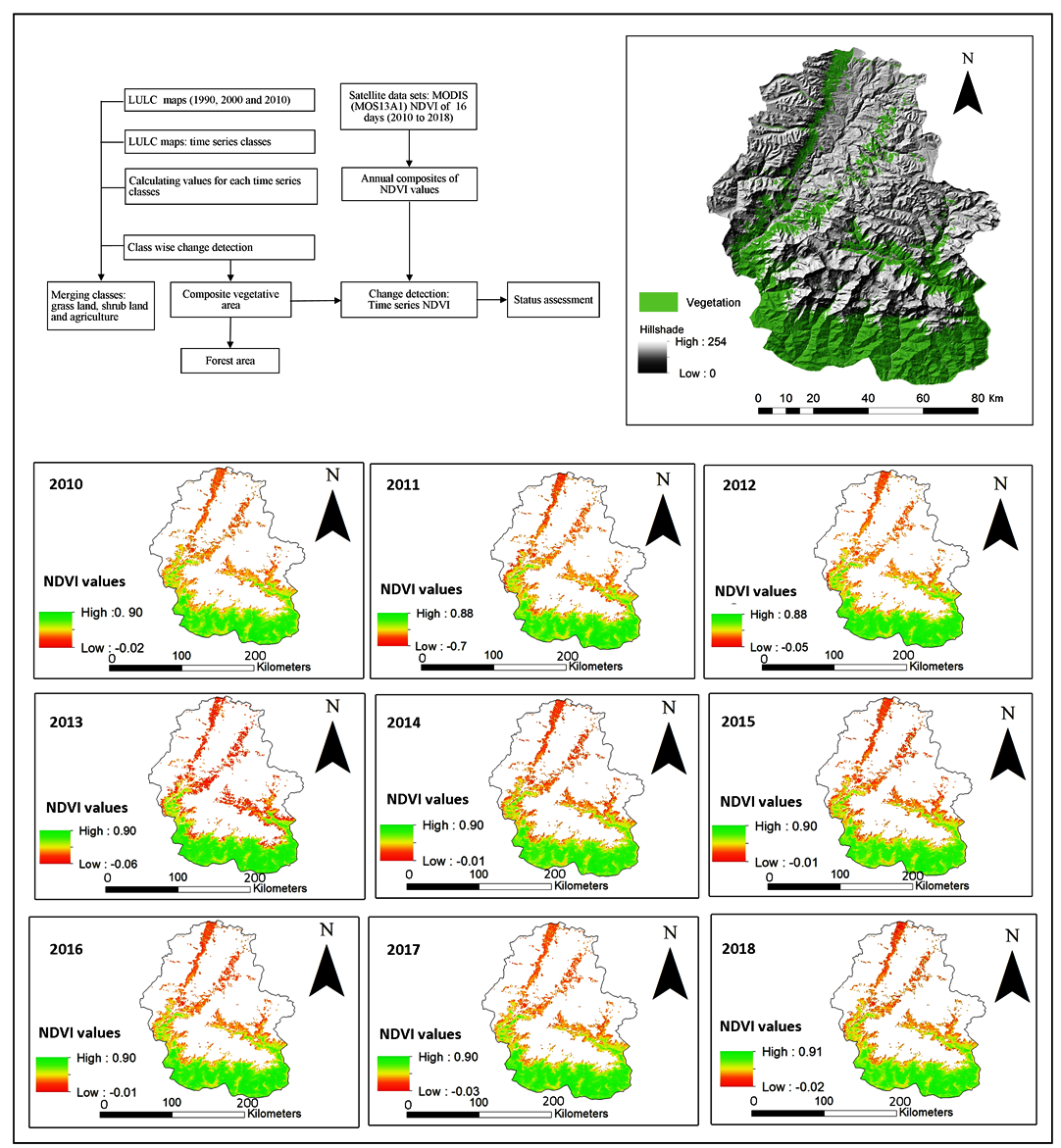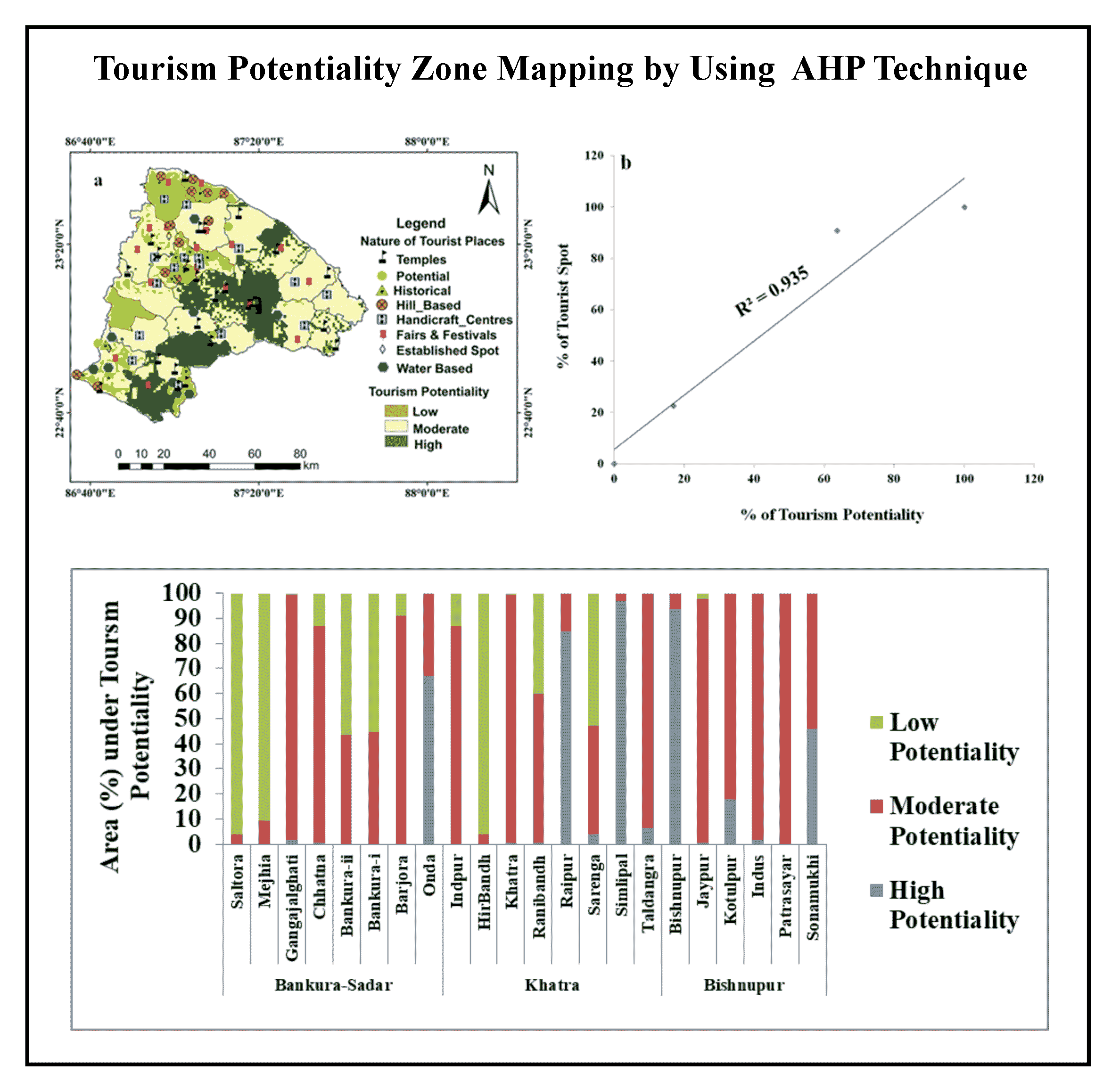Article Title :
Analysis of Land Use Land Cover in Annapurna Conservation Area in Gandaki Province Nepal using Vegetation Index and Land Use Land Cover Datasets 
2 (2018)
87-99
Annapurna Conservation Area , land use land cover , Land , NDVI , Nepal , Vegetation


Conservation areas are originally well-known for protecting landscape features and wildlife. They are playing key role in conserving and providing a wide range of ecosystem services, social, economic and cultural benefits as well as vital places for climate mitigation and adaptation. We have analyzed decadal changes in land cover and status of vegetation cover in the conservation area using both national level available data on land use land cover (LULC) changes (1990-2010) and normalized difference vegetation index (NDVI) (2010-2018) in Annapurna conservation area. LULC showed the barren land as the most dominant land cover types in all three different time series 1990, 2000 and 2010 with followed by snow cover, grassland, forest, agriculture and water body. The highest NDVI values were observed at Southern, Southwestern and Southeastern part of conservation area consisting of forest area, shrub land and grassland while toward low to negative in the upper middle to the Northern part of the conservation area.

LULC and NDVI datasets were used for accessing the status of vegetation and land inside the Annapurna Conservation Area.
The barren land is the most dominant land cover types in the study region.
The time series datasets are useful to detect the decade changes in land cover.
Maximum NDVI values were observed in the Southern and minimum in Northern parts of the study area.
The time series NDVI is useful for assessment and monitoring the conservation area in Nepal.
The findings of the study could enable to identify priority area for conservation and management strategy options for sustainable management of natural ecosystem in the conservation area.
ACAP [Annapurna Conservation Area Project], 2002. Annual Report.
Branney, P. and Yadav, K. P., 1998. Changes in Community Forestry Condition and Management 1994-98: Analysis of Information for the Forest Resource Assessment Study and Socio- Economic Study of the Koshi Hills. Project report G/NUKCFP/32, NUKCFP, Kathmandu.
CBS [Central Bureau of Statistics], 2011. Handbook of environment statistics. Central Bureau of Statistics, Kathmandu.
Chyurlia, J. P., 1984. Water Resources Report. Kathamndu Land Resource Project.
DFRS [Department of Forest Research and Survey], 2015. Middle Mountains Forests of Nepal. Forest Resource Assessment Nepal Project/Department of Forest Research and Survey (DFRS), Kathmandu, Nepal.
DFRS [Department of Forest Research and Survey]. 1999. Forest Resources of Nepal (1987-1998). FRISP Publication, 94. Department of Forest Research and Survey, Kathmandu, Nepal.
FAO [Food and Agriculture Organization]. 2015. Global Forest Resources. Rome, Italy. Food and Agriculture Organization of the United Nations.
FRA [Forest Resource Assessment], 2015. Forest Resource Assessment Nepal Project/ Department of Forest Research and Survey. Babarmahal, Kathmandu.
Inskipp, C. and Inskipp, T., 2001. A popular guide to the birds and mammals of the Annapurna Conservation Area. Pokhara, Nepal: KMTNC-Annapurna Conservation Area Project.
IPCC [Inter-governmental Panel on Climate Change], 2007. Contribution of Working Group III to the Fourth Assessment Report of the Inter-governmental Panel on Climate Change, Metz, B., Davidson, O.R., Bosch, P.R., Dave, R., Meyer, L.A., Eds.; Cambridge University Press: Cambridge, UK, New York, NY, USA, 863.
IPCC [Inter-governmental Panel on Climate Change], 2007. Synthesis report. In Fourth Assessment Report (AR4) of the Intergovernmental Panel on Climate Change, R. K. Pachauri and A. Reisinger (Eds), 25-73 (Geneva: IPCC).
Job, H. and Thomaser, M., 1996. Conservation for development: Nepal auf dem Weg zu einer integrierten Naturschutz- und Entwicklungspolitik? In: Zeitschrift für Wirtschaftsgeographie 40 (3), 144-155.
LRMP [Land Resource Mapping Project], 1986. Land Utilization Report. Land Resource Mapping Project, Kenting Earth Science Canada and Department of Topography, Government of Nepal, Kathmandu, Nepal, 112.
MoFSC [Ministry of Forests and Soil Conservation], 2009. Asia-Pacific Forestry Sector Outlook Study II: Nepal Forestry Outlook Study. Ministry of Forests and Soil Conservation. Singha Durbar, Kathmandu, Nepal, 83.
Sharma, P., 1994. Population and employment challenges in the mountains. In, Proceedings of the International Symposium on Mountain Environment and Development: Constraints and Opportunities. Kathmandu: ICIMOD.
Thakali, S., 2012. Localising environment: Mustang’s struggle to sustain village autonomy in environmental governance. PhD thesis, Canterbury, New Zealand.
Yengoh, G. T., Dent, D., Olsson, L., Tengberg, A. E. and Tucker, C. J., 2014. The Use of the Normalized Difference Vegetation Index (NDVI) to Assess Land Degradation at Multiple Scales: A Review of the Current Status, Future Trends, and Practical Considerations. Lund University Center for Sustainability Studies (LUCSUS), and the Scientific and Technical Advisory Panel of the Global Environment Facility (STAP/GEF).
Zeng, Y., Xiang, N. and Feng, Z., 2006. Albedo-NDVI space and remote sensing synthesis index models for desertification monitoring. Sci. Geog. Sin., 1, 75-81.





